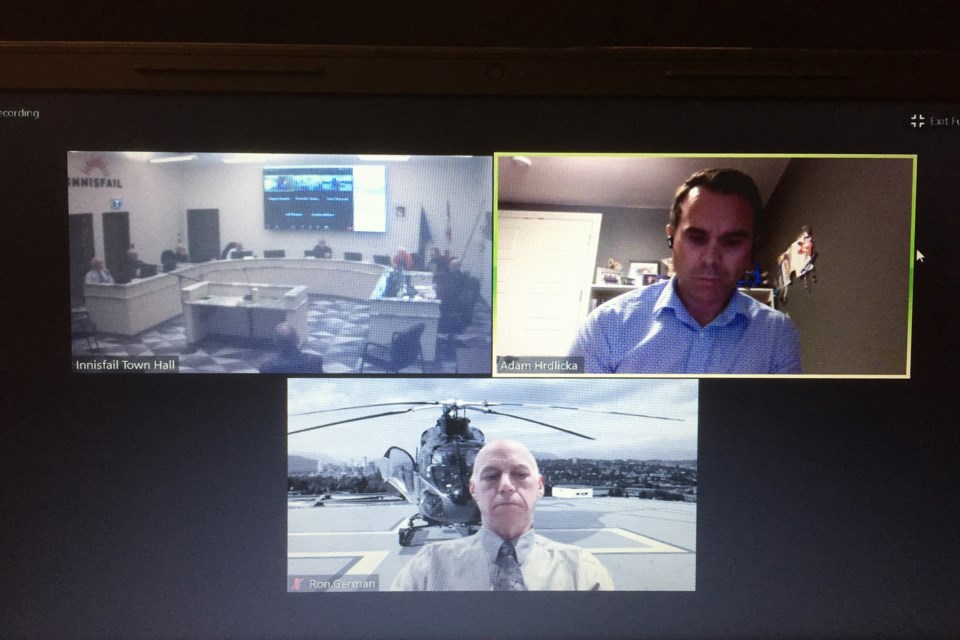INNISFAIL – All the cards were laid on the table for citizens last week for the future of the town’s obsolete heliport, and Innisfail’s hand shows the cost will be high to either modernize the facility or find a new site.
“What we are really looking at is how much is it going to cost and are we willing to pay that cost?” said Dr. Edmund Barker. “There is a big price. Nobody wants to discuss that but there is a cost. The question is, where is the line?”
The two-hour online community engagement session on Oct. 21 was hosted by the town to bring citizens and stakeholders up to date with the status of the 22-year-old heliport, which was voluntarily closed last June by the town after numerous Transport Canada non-compliances were identified. The town was given 12 months to determine if the heliport would be improved or reopened, relocated or closed. In the meantime, outbound air ambulance transfers have been moved to the Big Bend Airport, located just west of town.
Since the heliport's closure, town officials have dug deeper into the issues with the deteriorating site, and the public got its chance last week to hear firsthand from consultant Ron German of RG Heliservices. He was a former Transport Canada inspector responsible for British Columbia heliport inspections, certifications and assessments, and was recently retained by Alberta Health Services (AHS) to ensure all 72 provincial heliports could accommodate the new and larger H145 medevac helicopter.
“My primary goal is to make sure the site is safe for helicopters, air crew and people on the ground,” he said during his presentation, which included a video that identified several hazards — including sports field, roads, power lines, skatepark, and the aquatic centre — pilots must deal with when flying into the heliport.
“The surface of the heliport right now is in pretty rough shape. It’s had many rough winters, and there is only so long you can manage the surface,” said German, adding a rough heliport surface is also hazardous for patient transport. He noted the facility’s “old-fashioned lighting” presents another obstacle.
“My assessment at (this) point was that the whole pad has to be resurfaced,” he said, adding at least six people are needed to provide mandatory pedestrian control.
German said it would cost about $400,000 to modernize the heliport to Transport Canada standards. He added it would cost another $10,000 annually for ongoing maintenance.
For the town, the other ominous factor is liability, as the heliport, which it owns and manages, is in non-compliance and has no protection from Canadian aviation regulations.
“The responsibility does fall primarily with the town to make sure everything is safe. They just can’t refer back to STARS and say, ‘why did you come in if you didn’t think it was safe?’’’ said German. “STARS does ongoing risk assessments all the time. Pilots always do that. But the buck will stop with the town.”
Making the situation more challenging for the town is that local doctors want the heliport to be near the hospital, as it will cut down patient transportation time.
“There is no more relief when you are in that emergency department with a critical patient and that STARS team walks through the door,” said Dr. Gerald Miller, on behalf of Innisfail’s Rotary club, which spearheaded the building of the heliport in 1998. “We are limited on what we can do in a small hospital for the critical patients, whether it’s paediatrics, acute heart attack or stroke. That expertise is not available in Red Deer. Most people have to go to Calgary, and they have to go to Calgary now.
“It’s going to take a few dollars, but it’s doable and that location is critical in terms of the safety of patient transport between the hospital and the helicopter,” added Miller.
Coun. Glen Carritt said he wondered if the struggle was whether the heliport site was worth fixing and if the town should start thinking “outside the box” to look at a roof-top landing site or building a structure on the top of a parking lot.
“If we are going to spend $400,000 there, we need to look at other options or kibosh the deal and move it out to the airport,” said Carritt.
German said to retrofit a roof is “very complicated”, and an “expensive proposition in the millions.”
Meghan Jenkins, the town’s manager of community planning and sustainability who facilitated the engagement session, said the next step in the process is to get direction this month from town council, such as whether it wants administration to fine tune construction cost details for site upgrading, if more details are wanted on long-term operational costs, and if the town wants to begin a liability assessment.



